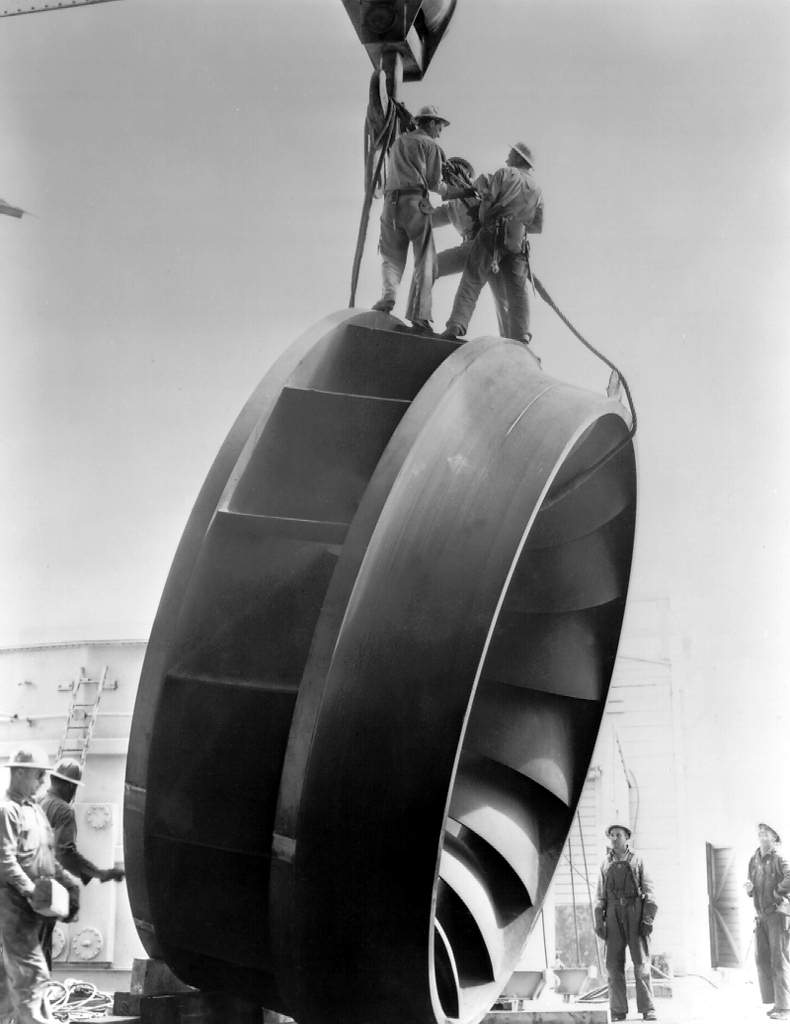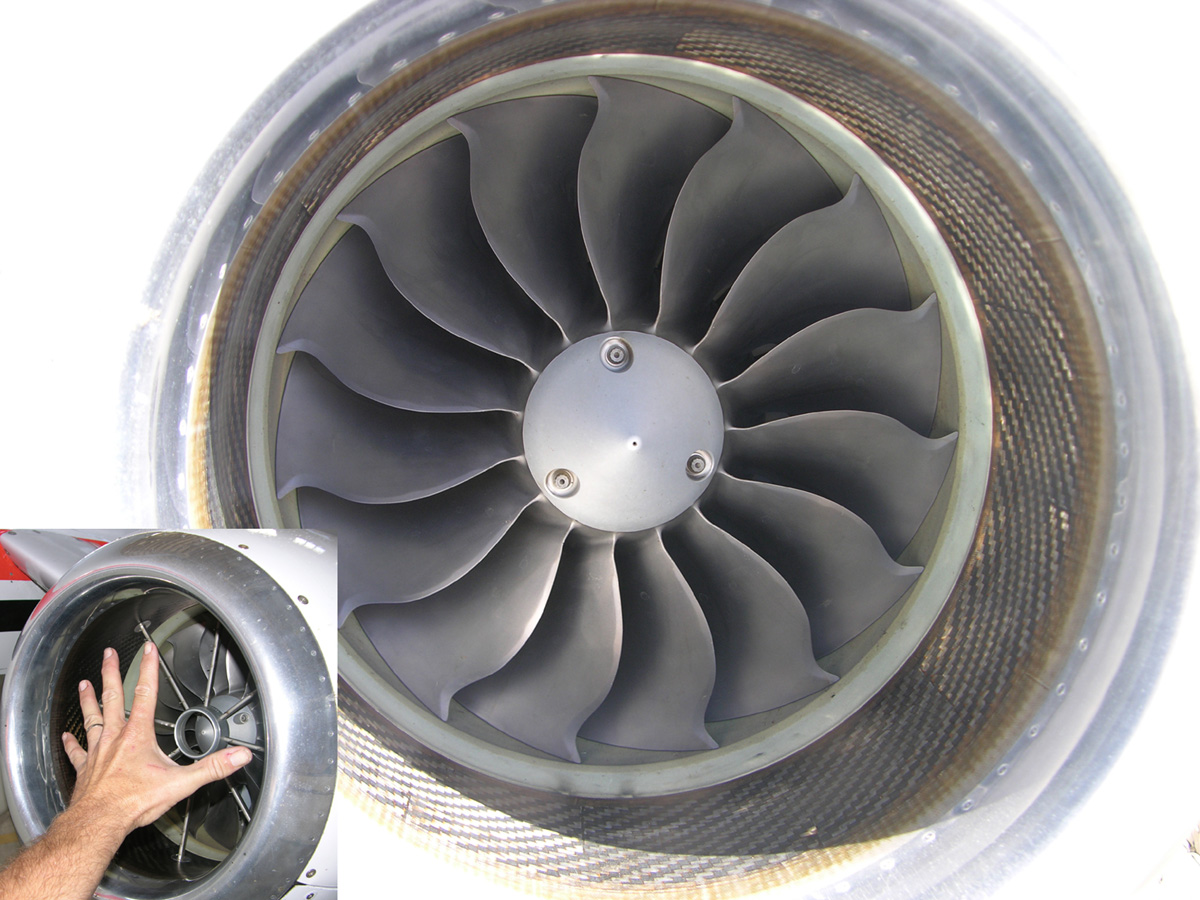|
Mixed Flow Compressor
A mixed flow compressor, or diagonal compressor, combines axial and radial components to produce a diagonal airflow compressor stage. The exit mean radius is greater than at the inlet, like a centrifugal design, but the flow tends to exit in an axial rather than radial direction. This eliminates the need for a relatively large diameter exit diffuser associated with centrifugal compressors. The impeller can be machined from solid using NC machines, in much the same way as that of a centrifugal design. Diagonal compressors were widely experimented during and just after World War II, but did not see much service use. A diagonal-flow compressor is featured since 2001 in the Pratt & Whitney Canada PW600 series turbofan engines used in the Phenom 100, Eclipse 500, Cessna Citation Mustang and other very light jet aircraft. See also * Gas compressor A compressor is a mechanical device that increases the pressure of a gas by reducing its volume. An air compressor is a specific type of g ... [...More Info...] [...Related Items...] OR: [Wikipedia] [Google] [Baidu] |
Centrifugal Compressor
Centrifugal compressors, sometimes called impeller compressors or radial compressors, are a sub-class of dynamic axisymmetric work-absorbing turbomachinery. They achieve pressure rise by adding energy to the continuous flow of fluid through the rotor/impeller. The following equation shows this specific energy input. A substantial portion of this energy is kinetic which is converted to increased potential energy/static pressure by slowing the flow through a diffuser. The static pressure rise in the impeller may roughly equal the rise in the diffuser. Equation-0.1 : H = \left( \left( R \right)_2 - \left( R \right)_1 \right) :where the control volume nomenclature (illustrated in Figure-0.4) is: ::* subscript, is the impeller inlet location, station1 ::* subscript, is the impeller discharge/exit location, station2 ::* is the energy input per unit mass, units=(LP/m) ::* is the impeller's rotation speed, units=(radians/t) ::* is the radius of specified location, units=(L) ::* is ve ... [...More Info...] [...Related Items...] OR: [Wikipedia] [Google] [Baidu] |
Impeller
An impeller or impellor is a rotor used to increase the pressure and flow of a fluid. It is the opposite of a turbine, which extracts energy from, and reduces the pressure of, a flowing fluid. In pumps An impeller is a rotating component of a centrifugal pump that accelerates fluid outward from the center of rotation, thus transferring energy from the motor that drives the pump to the fluid being pumped. The velocity achieved by the impeller transfers into pressure when the outward movement of the fluid is confined by the pump casing. An impeller is usually a short cylinder with an open inlet (called an eye) to accept incoming fluid, vanes to push the fluid radially, and a splined, keyed, or threaded bore to accept a drive shaft. It can be cheaper to cast an impeller and its spindle as one piece, rather than separately. This combination is sometimes referred to simply as the "rotor." Types Open impellers An open impeller has a hub with attached vanes and is mounted ... [...More Info...] [...Related Items...] OR: [Wikipedia] [Google] [Baidu] |
World War II
World War II or the Second World War, often abbreviated as WWII or WW2, was a world war that lasted from 1939 to 1945. It involved the vast majority of the world's countries—including all of the great powers—forming two opposing military alliances: the Allies and the Axis powers. World War II was a total war that directly involved more than 100 million personnel from more than 30 countries. The major participants in the war threw their entire economic, industrial, and scientific capabilities behind the war effort, blurring the distinction between civilian and military resources. Aircraft played a major role in the conflict, enabling the strategic bombing of population centres and deploying the only two nuclear weapons ever used in war. World War II was by far the deadliest conflict in human history; it resulted in 70 to 85 million fatalities, mostly among civilians. Tens of millions died due to genocides (including the Holocaust), starvation, ma ... [...More Info...] [...Related Items...] OR: [Wikipedia] [Google] [Baidu] |
Pratt & Whitney Canada PW600
The Pratt & Whitney Canada PW600 series is a family of small turbofan engines developed by Pratt & Whitney Canada producing between of thrust and powering the Eclipse 500/550, the Cessna Citation Mustang and the Embraer Phenom 100. Development The thrust PW625F demonstrator engine was first run on 31 October 2001. It flew in late 2002. In 2002, the PW610F was selected for the Eclipse 500 twinjet, replacing the EJ22 as Williams was unable to reach sufficient reliability. The thrust engine was certified by Transport Canada on 27 July 2006. The aircraft received a preliminary certification on 27 July 2006 and was forst delivered on 31 December 2006. The Eclipse 500 production was halted in October 2008 after 260 were delivered, and 33 of the updated Eclipse 550 were delivered between 2014 and 2017. The larger PW615F was selected to power the Cessna Citation Mustang in January 2003. The thrust engine was certified on June 26, 2006. The aircraft was certified on 8 September 2 ... [...More Info...] [...Related Items...] OR: [Wikipedia] [Google] [Baidu] |
Turbofan
The turbofan or fanjet is a type of airbreathing jet engine that is widely used in aircraft engine, aircraft propulsion. The word "turbofan" is a portmanteau of "turbine" and "fan": the ''turbo'' portion refers to a gas turbine engine which achieves mechanical energy from combustion, and the ''fan'', a ducted fan that uses the mechanical energy from the gas turbine to force air rearwards. Thus, whereas all the air taken in by a turbojet passes through the combustion chamber and turbines, in a turbofan some of that air bypasses these components. A turbofan thus can be thought of as a turbojet being used to drive a ducted fan, with both of these contributing to the thrust. The ratio of the mass-flow of air bypassing the engine core to the mass-flow of air passing through the core is referred to as the bypass ratio. The engine produces thrust through a combination of these two portions working together; engines that use more Propelling nozzle, jet thrust relative to fan thrust are ... [...More Info...] [...Related Items...] OR: [Wikipedia] [Google] [Baidu] |
Phenom 100
The Embraer EMB-500 Phenom 100 is a light business jet designed and produced by the Brazilian aircraft manufacturer Embraer. The project was announced in November 2005. On 26 July 2007, the aircraft made its first flight. It was awarded a type certificate in December 2008, and the first example was delivered the same month. It has been stretched into the larger Embraer Phenom 300. The very light jet can transport four to seven passengers, and is powered by two rear-mounted Pratt & Whitney Canada PW600 turbofans. It has a range of with four occupants. By the end of 2021, 392 had been delivered. The Phenom 100 was involved in a single fatal accident in December 2014. Development During April 2005, Embraer's board of directors approved the development of very light and light jets. Within ten years, it was hoped that the company could become a major provider for the global business jet market. On 9 November of that year, the company announced at the annual NBAA convention the n ... [...More Info...] [...Related Items...] OR: [Wikipedia] [Google] [Baidu] |
Eclipse 500
The Eclipse 500 (model EA500) is a very light jet (VLJ) originally produced by Eclipse Aviation of Albuquerque, New Mexico, United States. The company was founded in 1998 to develop the 1997 Williams V-Jet II demonstrator. The prototype first flew with Williams EJ22 turbofans on August 26, 2002. The engines were replaced by Pratt & Whitney Canada PW610Fs in 2004 and Eclipse Aviation won the Collier Trophy in February 2006 for the design. A provisional FAA type certification was received on 27 July 2006 and the first delivery occurred on 31 December 2006. The six-seat aircraft has an all-metal airframe with a T-tail and straight wings. It is powered by two turbofan engines in aft fuselage-mounted nacelles. The design is known for helping usher in a new category of VLJs when it was first delivered in late 2006. Production of the Eclipse 500 was halted in October 2008 due to lack of funding, after 260 aircraft had been delivered. On November 25 2008, Eclipse Aviation entered ... [...More Info...] [...Related Items...] OR: [Wikipedia] [Google] [Baidu] |
Cessna Citation Mustang
The Cessna Citation Mustang is a very light jet that was built by Cessna. Launched at the 2002 NBAA convention, the Model 510 first flew on April 23, 2005. It received its FAA type certification on September 8, 2006, and was first delivered on November 22. Production ended in 2017 after 479 aircraft were built. The MTOW jet is powered by two P&WC PW615F turbofans, can reach and has a range of . Development Launched at the 2002 NBAA convention, the $2.4 million Mustang first flew on April 23, 2005. The airplane received full type certification from the Federal Aviation Administration on September 8, 2006. Cessna received FAA certification to fly into "known icing conditions" on November 9, 2006. Cessna delivered the first production LJ on November 22, 2006, the same day the FAA awarded Cessna with the necessary certification. Dave and Dawn Goode of GOODE Ski Technologies received the first retail delivered Cessna Mustang on April 23, 2007. In 2010, Cessna launched an e ... [...More Info...] [...Related Items...] OR: [Wikipedia] [Google] [Baidu] |
Very Light Jet
A very light jet (VLJ), entry-level jet or personal jet, previously known as a microjet, is a category of small business jets seating four to eight people. VLJs are considered the lightest business jets and are approved for single-pilot operation. History The first small jet-powered civil aircraft, the 1950s Morane-Saulnier MS.760 Paris, has been retroactively suggested as being the first VLJ, as it seats four with a single pilot and is smaller than modern VLJs. The production of MS.760 differs from modern business jets in having a sliding canopy for cabin access rather than a door; a six-seat version with an enclosed cabin and a conventional door was canceled after a single prototype was built. Two unbuilt Cessna aircraft of the 1950s and 1960s would have met the definition of a VLJ. The first was the 407, a four-seat civil version of the T-37 jet trainer proposed in 1959; however, the 407 never progressed past the mockup stage due to insufficient customer interest. The seco ... [...More Info...] [...Related Items...] OR: [Wikipedia] [Google] [Baidu] |
Gas Compressor
A compressor is a mechanical device that increases the pressure of a gas by reducing its volume. An air compressor is a specific type of gas compressor. Compressors are similar to pumps: both increase the pressure on a fluid and both can transport the fluid through a pipe. The main distinction is that the focus of a compressor is to change the density or volume of the fluid, which is mostly only achievable on gases. Gases are compressible, while liquids are relatively incompressible, so compressors are rarely used for liquids. The main action of a pump is to pressurize and transport liquids. Many compressors can be staged, that is, the fluid is compressed several times in steps or stages, to increase discharge pressure. Often, the second stage is physically smaller than the primary stage, to accommodate the already compressed gas without reducing its pressure. Each stage further compresses the gas and increases its pressure and also temperature (if inter cooling between stages i ... [...More Info...] [...Related Items...] OR: [Wikipedia] [Google] [Baidu] |





.jpg)

